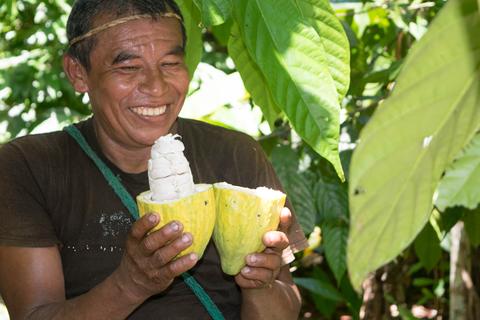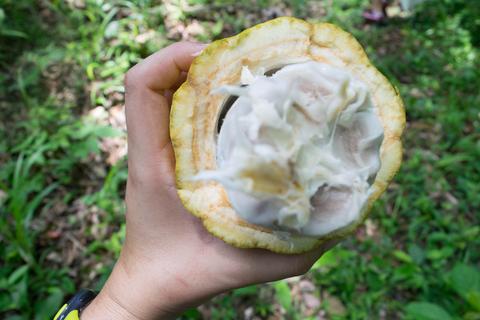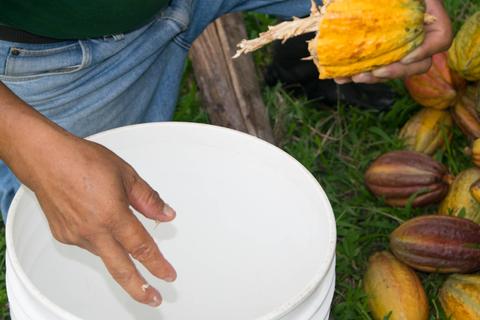My Journey Through Southern Belize: Cacao Farming & Harvesting (Part 1)
A little over a week ago, I found my time in southern Belize coming to an end, and I kept thinking about how much I had to share with you about the food, people, and culture I experienced during this unbelizeable (yes, yes, I said it again) trip.
I’ve managed to break it down into a three-part series: in this part, I’ll describe how I saw cacao being farmed and harvested, including a visit with a delightful local farmer and his family; in the second part, you’ll see how cacao beans are prepared for use; and lastly, I’ll share my experiences in the colorful Toledo district of southern Belize, which is Belize’s least visited district, and not quite what you see in ads for Belizean resorts.
When I arrived in Belize and spotted a cacao tree, I felt like a kid for the first time at Disney. It was surreal to pull a cacao pod off the tree, break it open, and eat the slightly sweet, tangy pulp in the middle of the jungle. While I’d read and learned about cacao in courses I’d taken, seeing the cacao tree firsthand brought me indescribable joy.
The cacao tree only grows ten to twenty degrees north and south of the equator and where it’s hot and rainy, which is why a climate like Belize’s is ideal. The tree grows cacao pods, and each pod bears the beans that are eventually made into chocolate. After three to five years, the trees start producing pods that are ready for harvesting.
Cacao pods start out as white flowers, and through the process of pollination, a small percentage of those flowers develop into pods. You see, many plants reproduce sexually, and the cacao tree is one of those. Each cacao flower has male and female parts, but they cannot fertilize themselves. Pollination can be achieved manually (by human hands), but the natural way is for tiny gnat-like insects, called midges, to pollinate the cacao flower.
The cacao pods can be a variety of colors, depending on the type of cacao tree. As the pods ripen, the color of the pods tends to become yellow, or yellow or orange in the creases.
The pods ripen after five to eight months. Once a cacao pod is ripe, you don’t want to leave it on the tree too long or it will decompose and die. Cacao pods aren’t like other fruits that fall off the tree when they are ripe.
I visited two cacao farms in southern Belize and saw how cacao is harvested and transformed into chocolate, largely by hand, and in any case, certainly on a small scale—the process is labor intensive.
One of the cacao farms I visited was Eladio Pop’s. In addition to being a gifted farmer (including farming cacao), Eladio is an inspiration—the smile on his face and the light in his eyes never left him the few hours we were with him. He is a truly happy man who feels blessed that he has been entrusted from above to grow cacao and share it with others.
Eladio and his wife have fifteen children—yes, fifteen children. Ahhhh, the aphrodisiacal nature of the cacao fruit! Would he and his wife consider adopting me as their sixteenth child so I could stay and farm with him?

Eladio walked us around his farm for over an hour. The farm actually looked like we were in the middle of the jungle—trees and plants of everything you can imagine growing everywhere—from cacao to sugarcane, bananas, pineapples, mangoes, ginger, and more.
Eladio’s approach to farming is more than just organic—everything has a purpose, and he was put on this Earth to see that it all works together. For instance, he understands that ants are his little gardeners. They create healthy soil by eating and helping decompose matter in the soil, and by digging tunnels and turning over dirt, so all he has to do is scoop it up and plant it around his trees as fertilizer.
Eladio took handfuls of the soil and used it to fertilize a few cacao trees. He then slowly twisted a few ripe cacao pods off a tree for us. If you aren’t careful in how you remove the pod from the tree, you’ll risk damaging the stem on the tree that attaches the pod to the tree and another cacao flower won’t grow from that same stem. Eladio used a machete to skillfully cut open the pod without damaging the pulp or beans inside. At another farm, the pod was opened by gently whacking it on a tree branch and then twisting the pod open.
The inside of a cacao pod is frighteningly amazing. The pulp surrounding the beans is a white to a subtle lavender color and subtly sweet.

Once each pod was opened, the pulp and beans were removed by hand.

I don’t think I would have ever looked at the pulp and even thought about tasting it, much less thought about fermenting, drying, and roasting it into something just as magical as chocolate. The pulp was delicious.
Eladio believes the cacao fruit is a healer. I tend to agree. And though we walked for over an hour, I couldn’t put down that pod—if I couldn't bring that pod back to the U.S. with me, I sure was hoping to harness as much of its power before I left!
As Eladio guided us up and down the steep hills at a furious pace, he fed us from his labor—in addition to feeding us cacao pulp, he handed us pieces of sugarcane, apple bananas, and more. I wish I hadn’t eaten breakfast!
We walked around Eladio’s farm as I balanced an opened cacao pod and sugarcane in one hand and camera in the other hand—nibbling on cacao pulp and biting into sugarcane along the way and managing to capture everything I could with my camera. It was a perfect beginning to my time in southern Belize.
After our hike, we hopped into the van that drove us to Eladio’s home to eat lunch and enjoy a hot drink made from cacao by his eldest daughter. In the next post, I’ll share how I saw cacao beans being prepared for use.
Leave a comment